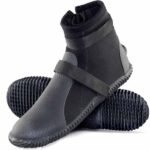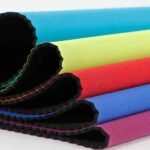Ever wondered how surfers and divers stay warm in cold water for hours without shivering? It seems like a wetsuit might be magical—but it’s all science and smart materials. The humble wetsuit is a marvel of design, engineering, and material science, allowing us to explore oceans, surf icy waves, or dive deep beneath the surface without freezing.
Wetsuits work by trapping a thin layer of water between your skin and the suit. Your body heats this water, and the neoprene insulates that warmth, keeping you comfortable even in cold water.
Let’s dive deeper into the incredible science behind wetsuits. We’ll explore what they’re made of, how they insulate your body, and answer common questions like: "Do you stay dry in a wetsuit?" and "What should you wear underneath?" Whether you’re a beginner swimmer or a brand looking to customize wetsuits, this guide has something for you.
What Is a Wetsuit and What Is It Made Of?
A wetsuit is a protective suit made from neoprene that provides thermal insulation in water.
- What is Neoprene? Neoprene is a type of synthetic rubber (polychloroprene) packed with tiny gas bubbles that trap heat and reduce water flow.
- Closed-Cell vs Open-Cell Neoprene:
| Type | Features | Usage |
|---|---|---|
| Closed-cell | Durable, waterproof, firm | Surfing, diving |
| Open-cell | Softer, more adhesive to skin, delicate | Freediving, spearfishing |
- Material Thickness: Typically ranges from 1mm to 7mm.
- Lining Materials: Nylon, polyester, and fleece for comfort and warmth.
Industry Insight: Most standard wetsuits use closed-cell neoprene with a nylon lining to balance durability and comfort.
How Does a Wetsuit Keep You Warm in Cold Water?
A wetsuit insulates your body by trapping a small layer of water and warming it with your body heat.
| Wetsuit Fit Quality | Insulation Efficiency | Comfort | Risk of Flushing |
|---|---|---|---|
| Too tight | Good but uncomfortable | Low | Low |
| Just right | Excellent | High | Minimal |
| Too loose | Poor | High | High |
Every millimeter counts. A 5mm suit provides more warmth than a 3mm suit but limits flexibility more.
Does Your Skin Get Wet When Wearing a Wetsuit?
Yes, your skin gets wet inside a wetsuit, but that’s how the insulation process works.
- Moisture Contact is Intentional
- How Wet Equals Warm
- Wetsuits vs Drysuits
Fun Analogy: Like a warm hug soaked in a thin water blanket—it’s cozy once you get used to it!
Do You Stay Dry Inside a Wetsuit?
No, you do not stay dry. A wetsuit retains water to create warmth.
| Feature | Dry Suit | Wetsuit |
|---|---|---|
| Keeps you dry | ✅ | ❌ |
| Lightweight | ❌ | ✅ |
| Warm water usage | ❌ | ✅ |
| Scuba diving (cold) | ✅ | ✅ (with thick suit) |
What Are the Different Types of Wetsuits?
Wetsuits come in various types, including full suits, shorties, and drysuits.
| Type | Coverage | Ideal Use Case | Water Temp |
|---|---|---|---|
| Full Suit | Full body | Surfing/Diving | < 65°F (18°C) |
| Shorty/Spring | Arms & legs cut | Warm water snorkeling | 65°F – 75°F |
| Drysuit | Fully sealed | Ice/Cold Water Diving | < 50°F (10°C) |
Which Thickness Wetsuit Should You Choose?
Choose wetsuit thickness based on water temperature and activity level.
| Water Temperature | Recommended Thickness | Suitable Activities |
|---|---|---|
| > 77°F (25°C) | 0.5mm – 1mm (or none) | Surfing, snorkeling |
| 65°F – 75°F | 2mm – 3/2mm | General water sports |
| 50°F – 64°F | 4/3mm – 5/4/3mm | Scuba diving, freediving |
| < 50°F | 6/5/4mm – 7mm | Ice diving, deep sea |
Tip: Avoid wetsuits in water above 77°F—it’s too warm and may lead to overheating.
How Does Wetsuit Fit Affect Performance?
A properly fitted wetsuit enhances insulation and movement while preventing flushing.
| Fit Issue | Symptom | Fix |
|---|---|---|
| Too tight | Restricted breathing | Size up |
| Too loose | Water pooling | Size down |
| Right fit | Snug with easy movement | Just right (buy it!) |
Do You Wear Anything Under a Wetsuit?
Yes, many wear swimwear, rash guards, or thermal layers under wetsuits.
| Base Layer Option | Best For | Pros |
|---|---|---|
| Swimwear (minimal) | Surfing, snorkeling | Light, unobtrusive |
| Rash guard | Extended water activity | UV protection, anti-rub |
| Thermal skin | Cold water diving | Extra warmth, snug fit |
Avoid: Cotton garments—they get heavy and cold when wet.
Are Neoprene Alternatives Used in Wetsuits?
Yes, sustainable materials like Yulex are becoming popular alternatives to traditional neoprene.
| Material | Stretch | Warmth | Eco-Friendly | Price Range | Durability |
|---|---|---|---|---|---|
| Petroleum Neoprene | High | High | Low | $$ | High |
| Limestone Neoprene | High | High | Medium | $$$ | High |
| Yulex Natural Rubber | Moderate | High | High | $$$$ | Moderate |
How Do You Take Care of a Wetsuit for Longevity?
Rinse with fresh water, air dry in shade, and store flat or on a wide hanger.
| Maintenance Step | Do’s | Don’ts |
|---|---|---|
| Rinse | With fresh cool water | With hot or salt water |
| Dry | In shaded ventilated space | In sun or dryer |
| Clean | With wetsuit shampoo | With bleach or soap |
| Store | Flat or wide hanger | Folded in storage bin |
<!DOCTYPE html>
Conclusion:
Whether you’re sourcing wetsuits for your brand or customizing gear for your surf team, understanding how a wetsuit works gives you a competitive edge. At Szoneier, we specialize in custom neoprene products, offering tailored solutions with free design, samples, and guaranteed quality.
Want to make your brand’s wetsuits stand out?
Contact us today to get started with your customized order. We support low MOQs, offer eco-material options, and deliver globally.















